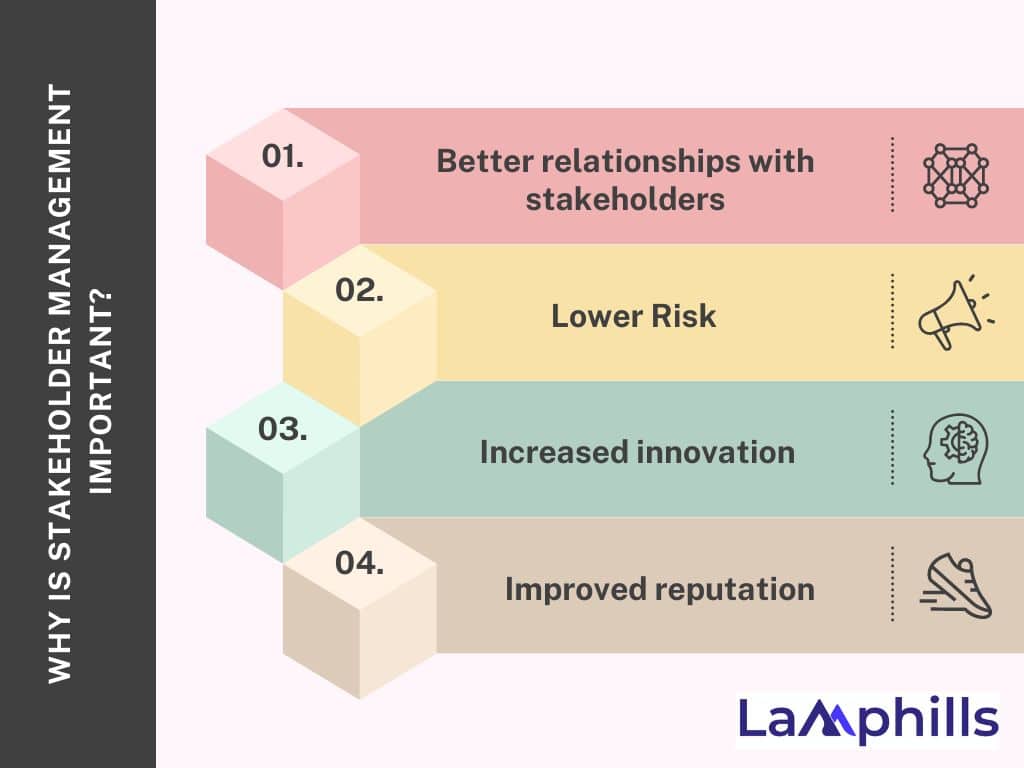Over time, I learned that effective stakeholder management is more than just holding meetings or giving updates. It’s about really understanding people, managing their expectations, and being flexible.
Also, successful projects aren’t just about meeting deadlines or getting approvals; they depend on how well you manage the people involved through clear communication, teamwork, and realistic goals. These are all key parts of effective stakeholder management.
In this article, you’ll learn what stakeholder management is, why it’s important, and how to create a stakeholder management plan. Keep reading.
Key Points
- Stakeholder management isn’t just about updates. It’s about understanding people, managing expectations, and fostering trust through clear communication.
- Mapping stakeholders based on their power and interest helps in prioritizing those who can influence the project and making informed decisions.
- Engaging with stakeholders early helps spot potential problems and encourages innovative ideas, leading to better project outcomes.
- Not every stakeholder needs the same approach—customizing communication and involvement strategies based on each stakeholder’s needs ensures more effective relationships.
- Regularly updating stakeholders and incorporating their feedback strengthens support, enhances decision-making, and keeps the project on track.
What is stakeholder management?
I once worked on a project with different teams, each with their own ideas and goals. The marketing team wanted something flashy, while the finance team was focused on keeping costs low. At first, it felt like everyone was pulling in different directions.
I quickly learned that the only way to keep things moving smoothly was to manage all these different expectations and priorities. It wasn’t always easy, but by staying organized, listening to everyone, and communicating clearly, I got everyone on the same page and delivered a successful project.
Stakeholder management means finding, understanding, and working with the people or groups interested in a project, organization, or decision. The main goal is to listen to and meet the needs of all stakeholders fairly and openly. This helps build trust and reduces any possible problems.
Good stakeholder management is essential for your organization to obtain necessary project approvals, resolve complaints, gain stakeholder support, and comply with any laws that could affect its financial performance.
Here are some questions to ask when starting the stakeholder management process:
- Who are your internal and external stakeholders?
- What are your stakeholders’ interests and needs?
- How can you best manage these interests, needs, and influences?
These questions help you identify your stakeholders, understand their needs, and determine the best way to manage their expectations and influence throughout the project.
Why is Stakeholder Management Important?

Successful projects rely on good stakeholder management. It’s essential. Today, companies no longer focus only on their own needs and react to problems later. Instead, they take a proactive approach, considering the different needs of their stakeholders.
This helps them handle challenges, reduce risks, and encourage new ideas. In the end, this leads to better results for businesses. Here are some key benefits of stakeholder management:
#1. Better relationships with stakeholders
Better relationships with stakeholders are essential in today’s connected world. Understanding their needs and concerns helps build trust, loyalty, and support. This can help businesses handle challenges, reduce risks, and encourage new ideas, leading to greater success.
#2. Lower Risk
When organizations work well with stakeholders, they can spot potential problems early and fix them before they become bigger issues. This helps avoid major complaints or delays that could threaten the project’s success.
#3. Increased innovation
Organizations that build good relationships with stakeholders can use their helpful ideas to create new solutions and make their products, services, and processes better.
#4. Improved reputation
Effectively managing and engaging with stakeholders can greatly boost a company’s reputation. Businesses that respect their stakeholders can get better media coverage, positive word-of-mouth, and stronger brand value. Investing in stakeholder engagement is a smart move that can lead to long-lasting benefits for both the company’s reputation and profits.
#5. Better decision-making
Organizations with a good stakeholder management strategy make better decisions because they listen to everyone’s views and needs. This helps them make more informed and balanced choices. By valuing stakeholders’ input, businesses can build stronger relationships, which leads to more trust, loyalty, and support. In the end, this helps improve their reputation and leads to a more successful business.
#6. Regulatory compliance
Stakeholder management is important when dealing with external groups like regulatory agencies and government bodies. These organizations often require companies to show that they have listened to and addressed stakeholders’ concerns during the application process for permits. By managing stakeholders well, businesses can meet these requirements and better understand their needs. This approach helps companies handle complex rules and build strong relationships with stakeholders, leading to long-term success.
#7. Social responsibility
As businesses work to include environmental, social, and governance (ESG) factors in their operations, managing stakeholders becomes even more important. By involving stakeholders, companies can figure out which ESG issues matter most and deal with any concerns. Listening to feedback and using it to shape their strategies can improve ESG performance and build strong stakeholder relationships. This focus on stakeholder management can also help businesses handle complicated regulations and achieve long-term success.
Now, let me show you how you can know who your stakeholders are.
The Step-By-Step Guide to Stakeholder Management
While managing stakeholders might feel natural for some, you can build trust more effectively by following a clear plan.
Here are six steps to help you understand what stakeholders need and how you can meet those needs.
#1. Identify Stakeholders
The first step to managing stakeholders well is to figure out who is involved. This includes people inside and outside your organization, like employees, customers, suppliers, regulators, shareholders, community members, government officials, and various groups that may be affected.
It’s important to make a complete list of everyone who might be interested in, impacted by, or influence your project. When identifying stakeholders, think broadly and include anyone who could affect or be affected by your organization’s decisions and actions.
How to Identify Internal Stakeholders
- Review the organizational chart to find important departments, teams, and individuals.
- Conduct employee surveys to understand their views and see who has a stake in specific projects or decisions.
- Look at job descriptions to identify people who may be affected by or have an impact on a project or decision.
- Ask managers and supervisors for insights on who in the organization will be most affected by or influential in a project or decision.
How to Identify External Stakeholders
- Research the business sector to identify key players like competitors, suppliers, and regulators.
- Review client and customer lists to find those with a strong interest in the organization’s activities.
- Conduct surveys with external groups like customers, suppliers, partners, and community leaders to understand their views.
- Identify influencers, activists, and the media as important stakeholders, and monitor media coverage and public discussions to find any overlooked stakeholders.
- Review laws and regulations related to your organization to identify regulatory bodies and other official entities as stakeholders.
- Analyze financials to find key stakeholders like investors, shareholders, and financial institutions.
- Examine your supply chain to identify vendors, suppliers, distributors, and other partners.
- Look at similar organizations or competitors to learn from their stakeholder engagement practices.
#2. Prioritize stakeholders.
Once you’ve identified your stakeholders, the next step is to figure out which ones are the most important for your project’s success.
Run a Stakeholder Mapping Exercise – Input the Map here.
You should consider their expectations, how much influence they have, what information they need from you, and how often they want updates. Stakeholder mapping can help you organize and prioritize the key people to focus on.
The stakeholder mapping exercise above asks you to place leaders on a grid with two axes: power and interest.
On the power axis, you rate how much each stakeholder can influence the project. On the interest axis, you rate how much each stakeholder cares about the project. This helps you see the most important stakeholders and how to engage with them effectively.
Here are a few ways to map stakeholders:
- RACI matrix: This method uses the letters R (Responsible), A (Accountable), C (Consulted), and I (Informed) to show each stakeholder’s role and involvement in the project.
- Power/interest grid: A simple method that helps you prioritize stakeholders based on their power and interest, also called the Salience model.
- Influence/impact matrix: A more detailed method to assess how much each stakeholder can impact the project.
#3. Understand stakeholder needs and interests.
A successful stakeholder management plan starts with understanding the people involved. This helps you figure out what they want from the project and how to work with them.
At this point, ask yourself these questions:
- Do you know their needs, priorities, and concerns?
- Can they affect the project’s success?
- Do they have a financial or emotional interest in the project’s outcome?
- What drives them?
By knowing the answers, you can create a plan that fits each stakeholder better.
#4. Understand what stakeholders want.
After identifying your stakeholders, it’s important to figure out their motives. This will help you understand what they expect from the project and how to work with them effectively.
There are different ways to find out what stakeholders want, such as:
- Interviews: Talk to stakeholders directly to hear their thoughts on the project, either in person, by phone, or through email.
- Surveys: Send out surveys to gather feedback from a large group of stakeholders quickly.
- Focus groups: Organize discussions with stakeholders to get their ideas and opinions and to identify any concerns.
By understanding what your stakeholders want, you can create a plan that meets their needs and keeps them engaged in the project.
#5. Create a plan for engaging stakeholders.
The goal of stakeholder engagement is to manage their expectations and build strong relationships. You can do this in several ways:
- Regular communication: This is the most important part. Keep stakeholders updated on the project and get their feedback often. You can do this through meetings, phone calls, emails, or using project management tools. Each stakeholder may need their own way of being communicated with.
- Consulting: This means involving stakeholders in decision-making. You can ask for their input through meetings, surveys, or focus groups.
- Collaborating: This means working with stakeholders to complete tasks or reach goals together. You can do this by planning together or sharing decisions.
The best way to engage with each stakeholder will depend on the project and the individual. Tailor your plan to fit each person.
Here’s a simple template to help you create your Stakeholder Engagement Plan. It will guide you in organizing how to communicate with and involve your stakeholders throughout the project.
Using this template will ensure that everyone is kept informed, their feedback is collected, and any concerns are addressed. Download the template below and start planning!
Now, let me show you how to create a Stakeholder Management Plan.
How to Create an Effective Stakeholder Management Plan
Good communication is key to successfully managing both on-site and remote projects. While planning can feel challenging, it plays a big role in whether a project succeeds or fails.
A good stakeholder plan should consider everyone and everything affected by the project, this could include people, organizations, businesses, families, government groups, and even land, trees, crops, or animals. Some projects need to consider these many details to be successful.
Before we discuss how to develop a plan, let’s define a stakeholder management plan.
What is a Stakeholder Management Plan?
A stakeholder management plan is a guide that helps your organization communicate effectively with key people involved in your project. It outlines how to engage with stakeholders to improve the chances of a successful project outcome.
This plan is a written document that identifies the main stakeholders and explains how to communicate with them. It helps the project manager manage expectations and deliver the right information to the right people at the right time.
A stakeholder management plan works closely with stakeholder analysis to find the best communication methods. This can help reduce misunderstandings, increase positive feedback, and resolve issues before they become bigger problems.
Preparing a Stakeholder Engagement Plan (SEP)
From our experience, a strong stakeholder engagement plan usually has 12 parts. Here’s a brief summary:
#1. Areas of Influence
This section clearly shows the areas affected by the project and shows the amount of engagement needed in each area, from very little to a lot.
#2. Regulations and Requirements
Most projects must follow certain rules and regulations. It’s important to ensure that the project meets these rules at all times.
#3. Methodology
Choosing the right approach is key, as it forms the base of your plan. This part explains how you will identify and group your stakeholders.
#4. Project Stakeholders
In this part of your Stakeholder Engagement Plan, you’ll create a complete list of all the groups and sub-groups you identified earlier. This list includes details about important leaders, communities, and other key people.
#5. Stakeholder Engagement Activities
The activities section is an important part of your plan. It outlines how you will communicate with each group you identified. It helps you understand each group’s unique needs so you can adjust your communication strategies to suit them.
#6. Stakeholder Engagement Plan Template
Once you’ve identified your stakeholders and figured out how to reach them, you can start filling out a stakeholder engagement plan template. This will help you put your strategy into action when it’s time to manage your stakeholders.
#7. Timetable
This part gives a simple overview of the communication plan for each phase of the project over time. You don’t need to go into too much detail; checking in monthly is a good idea.
#8. Resources and Responsibilities
Clearly explain what each team member is responsible for and who they report to if there’s a problem. Include job descriptions with names and an organizational chart to show who is in charge of what. Also, mention the roles of any outside contractors.
#9. Grievance Management
Stakeholders should know what counts as a grievance and how it will be handled, including how long it will take to resolve. Make sure they can easily ask for this information when needed.
#10. Monitoring and Reporting
Using a Stakeholder Relationship Management (SRM) system is more effective and secure than using separate tools like email, spreadsheets, or shared documents. With an SRM, all your information is in one place, making finding details from past interactions easier and faster.
#11. Budget
You also need to keep track of the costs of your stakeholder engagement activities. Try to include as much detail as possible in your budget, and remember to review it regularly to stay on track.
#12. Appendix
In the Appendix, you can include important documents like your PAP list, templates for complaint forms, and attendance records for meetings. Adding links to other documents related to your stakeholder engagement plan can also be helpful.
Tips for Effective Stakeholder Management- Best Practices.

Building strong relationships with stakeholders is key to keeping them engaged. However, having a good relationship doesn’t always mean that every stakeholder will always be satisfied.
The foundation of positive stakeholder relationships is trust. Clear and open communication is crucial, so creating honest and easy ways for stakeholders to share their thoughts and feel valued is important.
Let’s look at some strategies to improve relationships with stakeholders.
#1. Clearly define the project’s purpose.
According to PMI, 44% of projects fail because they don’t align with the business’s goals. Before talking to stakeholders, it’s important to clearly define the project’s purpose. This will help you know who to involve and understand their goals.
#2. Define roles and responsibilities.
At the beginning of a project, make sure each stakeholder knows their role and what they are responsible for. This helps everyone understand their part in the project.
#3. Communicate regularly.
Regular communication is key to managing stakeholders effectively. Update them on the project’s progress and ask for their feedback. Always be clear about your goals when talking to stakeholders. This helps manage their expectations and builds positive relationships.
#4. Be open and honest.
It’s important to be open with stakeholders about the project. This helps build trust and ensures everyone understands what’s happening.
#5. Ask for feedback.
Getting feedback from stakeholders is key to successful management. You should ask for their input at every stage of the project.
Keep track of their suggestions and try to use their ideas. Then, let them know how you used their feedback to gain even more support.
#6. Pick the right software.
Only about one in four teams uses project management software, but using these tools can help you stay organized. Options include project management software like Basecamp or Asana or collaboration tools like Google Drive or Trello. Choose the tools that work best for your project’s needs.
#7. Stay flexible.
Managing stakeholders isn’t the same for everyone. Be flexible and adjust your approach to fit each person you work with.
Wrap Up.
Managing stakeholders can sometimes feel overwhelming, but with the right approach, it becomes much easier. By identifying your stakeholders, understanding their needs, communicating effectively, managing expectations, staying adaptable, and keeping track of engagement, you can ensure that everyone stays on the same page and the project stays on track.
Remember, the goal of stakeholder management isn’t just to avoid conflicts—it’s to build strong, collaborative relationships that lead to successful outcomes. Whether you’re working on a small project or a large campaign, these principles will help you manage your stakeholders with confidence and ease.
Frequently Asked Questions
What is another name for stakeholder management?
Stakeholder management is also known as stakeholder engagement, community engagement, public consultation, civic engagement, public participation, and other similar terms.
What are the 7 C’s of stakeholder management?
The seven key areas (7 C’s) are customers, competitors, skills, money, distribution channels, communication, and teamwork.
What are the four major components of the stakeholder management plan?
The stakeholder management plan helps the project manager to:
– Find out who the stakeholders are.
– Handle their expectations.
– Involve them in the project.
– Keep track of their involvement.
What are the four Ps of stakeholders?
The four Ps are a simple way to describe key stakeholders. They are the Policymakers, Payers, Providers, and, most importantly, the Patients. While their roles may vary slightly depending on the situation, they all share the same basic meaning.
What are the three key rules for managing stakeholders?
The three key rules for managing stakeholders are trust, impact, and communication. Trust is the most important. You need to build and keep trust with your stakeholders. By doing this, you can become a trusted advisor who helps them make decisions based on good information.
What are the three types of stakeholders?
Some researchers and frameworks may use different terms, but one study breaks down stakeholder engagement into three levels:
1. Level 1 – Information Strategy: This involves tracking and informing stakeholders.
2. Level 2 – Response Strategy: This level includes consulting and offering support to stakeholders.
3. Level 3 – Involvement Strategy: This level involves stakeholders directly.
Similar Articles
Social Media Crisis Management: How to Handle Negative Feedback and Protect Your Brand
10 Essential Strategies For Effective International Brand Management
9 Reputation Management Red Flags That Scream






